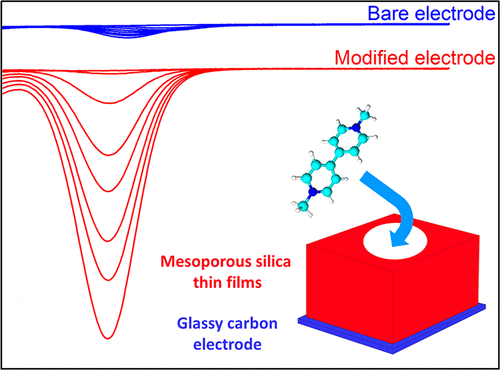Our official English website, www.x-mol.net, welcomes your feedback! (Note: you will need to create a separate account there.)
Mesoporous Silica Thin Films for Improved Electrochemical Detection of Paraquat
ACS Sensors ( IF 8.9 ) Pub Date : 2018-01-30 00:00:00 , DOI: 10.1021/acssensors.7b00920 Tauqir Nasir 1 , Grégoire Herzog 1 , Marc Hébrant 1 , Christelle Despas 1 , Liang Liu 1 , Alain Walcarius 1
ACS Sensors ( IF 8.9 ) Pub Date : 2018-01-30 00:00:00 , DOI: 10.1021/acssensors.7b00920 Tauqir Nasir 1 , Grégoire Herzog 1 , Marc Hébrant 1 , Christelle Despas 1 , Liang Liu 1 , Alain Walcarius 1
Affiliation

|
An electrochemical method was developed for rapid and sensitive detection of the herbicide paraquat in aqueous samples using mesoporous silica thin film modified glassy carbon electrodes (GCE). Vertically aligned mesoporous silica thin films were deposited onto GCE by electrochemically assisted self-assembly (EASA). Cyclic voltammetry revealed effective response to the cationic analyte (while rejecting anions) thanks to the charge selectivity exhibited by the negatively charged mesoporous channels. Square wave voltametry (SWV) was then used to detect paraquat via its one electron reduction process. Influence of various experimental parameters (i.e., pH, electrolyte concentration, and nature of electrolyte anions) on sensitivity was investigated and discussed with respect to the mesopore characteristics and accumulation efficiency, pointing out the key role of charge distribution in such confined spaces on these processes. Calibration plots for paraquat concentration ranging from 10 nM to 10 μM were constructed at mesoporous silica modified GCE which were linear with increasing paraquat concentration, showing dramatically enhanced sensitivity (almost 30 times) as compared to nonmodified electrodes. Finally, real samples from Meuse River (France) spiked with paraquat, without any pretreatment (except filtration), were analyzed by SWV, revealing the possible detection of paraquat at very low concentration (10–50 nM). Limit of detection (LOD) calculated from real sample analysis was found to be 12 nM, which is well below the permissible limits of paraquat in drinking water (40–400 nM) in various countries.
中文翻译:

介孔二氧化硅薄膜用于改进百草枯的电化学检测
开发了一种电化学方法,用于使用介孔二氧化硅薄膜修饰的玻碳电极(GCE)快速灵敏地检测水性样品中的除草剂百草枯。通过电化学辅助自组装(EASA)将垂直排列的介孔二氧化硅薄膜沉积到GCE上。循环伏安法显示出对阳离子分析物的有效响应(同时排斥阴离子),这是由于带负电的中孔通道具有电荷选择性所致。然后使用方波伏安法(SWV)通过其一电子还原过程检测百草枯。研究并讨论了各种实验参数(例如pH值,电解质浓度和电解质阴离子的性质)对灵敏度的影响,并针对中孔特性和积累效率进行了讨论,指出了电荷在这些过程中在有限空间中的关键作用。在介孔二氧化硅改性的GCE上建立了百草枯浓度范围为10 nM至10μM的校准图,该曲线与百草枯浓度呈线性关系,与未修饰的电极相比,灵敏度显着提高(几乎30倍)。最后,SWV分析了来自法国默兹河的未经百草枯加标的百草枯的真实样品,未经任何预处理(过滤除外),揭示了可能以非常低的浓度(10–50 nM)检测百草枯的方法。通过实际样品分析计算得出的检出限(LOD)为12 nM,远低于各个国家饮用水中百草枯的允许极限(40-400 nM)。
更新日期:2018-01-30
中文翻译:

介孔二氧化硅薄膜用于改进百草枯的电化学检测
开发了一种电化学方法,用于使用介孔二氧化硅薄膜修饰的玻碳电极(GCE)快速灵敏地检测水性样品中的除草剂百草枯。通过电化学辅助自组装(EASA)将垂直排列的介孔二氧化硅薄膜沉积到GCE上。循环伏安法显示出对阳离子分析物的有效响应(同时排斥阴离子),这是由于带负电的中孔通道具有电荷选择性所致。然后使用方波伏安法(SWV)通过其一电子还原过程检测百草枯。研究并讨论了各种实验参数(例如pH值,电解质浓度和电解质阴离子的性质)对灵敏度的影响,并针对中孔特性和积累效率进行了讨论,指出了电荷在这些过程中在有限空间中的关键作用。在介孔二氧化硅改性的GCE上建立了百草枯浓度范围为10 nM至10μM的校准图,该曲线与百草枯浓度呈线性关系,与未修饰的电极相比,灵敏度显着提高(几乎30倍)。最后,SWV分析了来自法国默兹河的未经百草枯加标的百草枯的真实样品,未经任何预处理(过滤除外),揭示了可能以非常低的浓度(10–50 nM)检测百草枯的方法。通过实际样品分析计算得出的检出限(LOD)为12 nM,远低于各个国家饮用水中百草枯的允许极限(40-400 nM)。



























 京公网安备 11010802027423号
京公网安备 11010802027423号